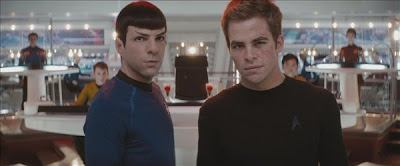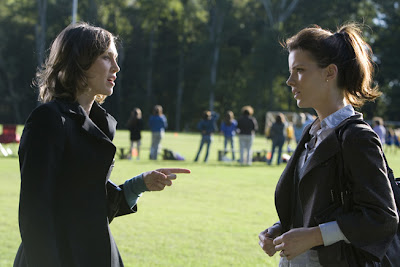
Larry Daley: Ben Stiller
Amelia Earhart: Amy Adams
Jedediah Smith: Owen Wilson
Kahmunrah/voice of The Thinker/voice of Abraham Lincoln: Hank Azaria
Teddy Roosevelt: Robin Williams
Ivan the Terrible: Christopher Guest
Napoleon Bonaparte: Alain Chabat
Octavius: Steve Coogan
Dr. McPhee: Ricky Gervais
Col. George Armstrong Custer: Bill Hader
20th Century Fox presents a film directed by Shawn Levy. Written by Robert Ben Garant & Thomas Lennon. Running time: 105 min. Rated PG (for mild action and brief language).
I read a user comment about “Night at the Museum: Battle of the Smithsonian” on IMdb.com posted by Digory from Philippines. It was titled “An Afternoon in the Theater: The Battle to Stay Amused”, and there is perhaps no better description of this sequel to the 2006 box office hit “Night at the Museum” than that title designed to mock this new adventure. In fact, it describes the original film pretty well too. Rarely have I seen a cast of characters and special effects battle so relentlessly to amuse than in these two movies, and rarely have I seen such effort produce such little effect.
The plot of the first film couldn’t be more basic. Ben Stiller (“Tropic Thunder”) is Larry Daley, the new night security guard for the Museum of Natural History in New York City. Once he takes the job he discovers the museum houses the magical tablet of Ahkmenrah (Rami Malek), which brings all the exhibits to life after sunset. Of course, someone realizes the power of such a device and tries to steal it. Daley must thwart the villain to save the exhibits in the museum; all the while dealing with all these displaced historical figures’ personality quirks.
“Night at the Museum: Battle of the Smithsonian” is pretty much a Xeroxed copy of that plot, but instead of the Museum of Natural History coming to life, the tablet has been moved to the Smithsonian in Washington, D.C.—the largest museum on Earth. Since the MONH has decided to replace most of its exhibits with interactive holograms, most of the cast from the original has been shipped to storage under the Smithsonian, creating a convenient loophole allowing fans to see all their favorite characters in this new adventure.
Although to refer to any of the figures in the movie as characters is a stretch. They are really just personality representations of the actors playing them. There are so many personalities in this movie that there is really no attempt to get to know any of them, including the leads. Stiller’s Daley is as much a nobody in this picture as he was in the first. He seems to exist only for his verbal disbelief reactions to all the craziness around him. He has a good moment where he attempts to steal a security pass from one of the Smithsonian guards played by Jonah Hill (“Superbad”). Poor Hill is never seen again after that scene, however.
In fact, most of the performers are only given a moment or two to prove their worth before being discarded. Bill Hader, of “Saturday Night Live” fame, shows up to give life to General Custer and only gets a bit where he can’t seem to pronounce Sacajawea’s name properly. Christopher Guest (“This is Spinal Tap”) is cast as Ivan the Terrible and is neither terrible nor funny. Not his fault, he’s never given anything funny to do or say. French comedian Alain Chabat is brought in to make every short joke about Napoleon Bonaparte that has already been made. Haha, hehe. And the talented Hank Azaria plays the main villain, Kahmunrah with a lisp that seems contrived to disguise his voice from those of the other characters whose dialogue he provides. Or perhaps he didn’t want the villain to sound like Moe from “The Simpsons”.
Returning to add little to this adventure are the wasted talents of Robin Williams as Teddy Roosevelt, Ricky Gervais (HBO’s “Extras”) as MONH curator Dr. McPhee, Steve Coogan (“Hamlet 2”) as the miniature Roman soldier Octavius, and Owen Wilson (“Marley & Me”) as a miniature cowboy. Coogan and Wilson seem to be switched more to the setting of annoy than amuse. Again it’s their material that’s lacking, not their talent.
The only thing I found remotely worth watching here was Amy Adams (“Enchanted”) as Amelia Earhart. Adams may very well possess the ability to make anyone fall in love with anything. I now think Amelia Earhart must have been the most precious American resource this country ever lost, but her character actually seems to have been given some attention by screenwriters Robert Ben Garant and Thomas Lennon (both formerly of the sketch-comedy troupe “The State” and currently performers and writers for the “COPS” spoof show “Reno 911!”). They’ve given her clever dialogue, spoofing the movie speech style of the 1930s. Plus, she is the only character with a clearly defined philosophy and dramatic arc.
For a movie with no character development, I’ve certainly spent a good deal of time discussing the characters; but there’s very little else to discuss with this movie. Certainly the 19 museums and 9 research centers that make up the Smithsonian gave director Shawn Levy (“The Pink Panther”) a good amount of material to exploit for action and special effects sequences, yet only three of the museums are prominently featured in the movie. And there seems to be an awful lot of huffing and puffing going on to provide the audience with an adventure they won’t forget, but huffing and puffing is really all there is here.
“Night at the Museum: Battle of the Smithsonian” isn’t really a bad movie, just forgettable. I’ve been to the Smithsonian, and I would recommend you save your money from not seeing movies like this, so you can go to the Smithsonian yourself. Even if you only see one of their exhibits, it will stick with you much longer than this movie will.
Amelia Earhart: Amy Adams
Jedediah Smith: Owen Wilson
Kahmunrah/voice of The Thinker/voice of Abraham Lincoln: Hank Azaria
Teddy Roosevelt: Robin Williams
Ivan the Terrible: Christopher Guest
Napoleon Bonaparte: Alain Chabat
Octavius: Steve Coogan
Dr. McPhee: Ricky Gervais
Col. George Armstrong Custer: Bill Hader
20th Century Fox presents a film directed by Shawn Levy. Written by Robert Ben Garant & Thomas Lennon. Running time: 105 min. Rated PG (for mild action and brief language).
I read a user comment about “Night at the Museum: Battle of the Smithsonian” on IMdb.com posted by Digory from Philippines. It was titled “An Afternoon in the Theater: The Battle to Stay Amused”, and there is perhaps no better description of this sequel to the 2006 box office hit “Night at the Museum” than that title designed to mock this new adventure. In fact, it describes the original film pretty well too. Rarely have I seen a cast of characters and special effects battle so relentlessly to amuse than in these two movies, and rarely have I seen such effort produce such little effect.
The plot of the first film couldn’t be more basic. Ben Stiller (“Tropic Thunder”) is Larry Daley, the new night security guard for the Museum of Natural History in New York City. Once he takes the job he discovers the museum houses the magical tablet of Ahkmenrah (Rami Malek), which brings all the exhibits to life after sunset. Of course, someone realizes the power of such a device and tries to steal it. Daley must thwart the villain to save the exhibits in the museum; all the while dealing with all these displaced historical figures’ personality quirks.
“Night at the Museum: Battle of the Smithsonian” is pretty much a Xeroxed copy of that plot, but instead of the Museum of Natural History coming to life, the tablet has been moved to the Smithsonian in Washington, D.C.—the largest museum on Earth. Since the MONH has decided to replace most of its exhibits with interactive holograms, most of the cast from the original has been shipped to storage under the Smithsonian, creating a convenient loophole allowing fans to see all their favorite characters in this new adventure.
Although to refer to any of the figures in the movie as characters is a stretch. They are really just personality representations of the actors playing them. There are so many personalities in this movie that there is really no attempt to get to know any of them, including the leads. Stiller’s Daley is as much a nobody in this picture as he was in the first. He seems to exist only for his verbal disbelief reactions to all the craziness around him. He has a good moment where he attempts to steal a security pass from one of the Smithsonian guards played by Jonah Hill (“Superbad”). Poor Hill is never seen again after that scene, however.
In fact, most of the performers are only given a moment or two to prove their worth before being discarded. Bill Hader, of “Saturday Night Live” fame, shows up to give life to General Custer and only gets a bit where he can’t seem to pronounce Sacajawea’s name properly. Christopher Guest (“This is Spinal Tap”) is cast as Ivan the Terrible and is neither terrible nor funny. Not his fault, he’s never given anything funny to do or say. French comedian Alain Chabat is brought in to make every short joke about Napoleon Bonaparte that has already been made. Haha, hehe. And the talented Hank Azaria plays the main villain, Kahmunrah with a lisp that seems contrived to disguise his voice from those of the other characters whose dialogue he provides. Or perhaps he didn’t want the villain to sound like Moe from “The Simpsons”.
Returning to add little to this adventure are the wasted talents of Robin Williams as Teddy Roosevelt, Ricky Gervais (HBO’s “Extras”) as MONH curator Dr. McPhee, Steve Coogan (“Hamlet 2”) as the miniature Roman soldier Octavius, and Owen Wilson (“Marley & Me”) as a miniature cowboy. Coogan and Wilson seem to be switched more to the setting of annoy than amuse. Again it’s their material that’s lacking, not their talent.
The only thing I found remotely worth watching here was Amy Adams (“Enchanted”) as Amelia Earhart. Adams may very well possess the ability to make anyone fall in love with anything. I now think Amelia Earhart must have been the most precious American resource this country ever lost, but her character actually seems to have been given some attention by screenwriters Robert Ben Garant and Thomas Lennon (both formerly of the sketch-comedy troupe “The State” and currently performers and writers for the “COPS” spoof show “Reno 911!”). They’ve given her clever dialogue, spoofing the movie speech style of the 1930s. Plus, she is the only character with a clearly defined philosophy and dramatic arc.
For a movie with no character development, I’ve certainly spent a good deal of time discussing the characters; but there’s very little else to discuss with this movie. Certainly the 19 museums and 9 research centers that make up the Smithsonian gave director Shawn Levy (“The Pink Panther”) a good amount of material to exploit for action and special effects sequences, yet only three of the museums are prominently featured in the movie. And there seems to be an awful lot of huffing and puffing going on to provide the audience with an adventure they won’t forget, but huffing and puffing is really all there is here.
“Night at the Museum: Battle of the Smithsonian” isn’t really a bad movie, just forgettable. I’ve been to the Smithsonian, and I would recommend you save your money from not seeing movies like this, so you can go to the Smithsonian yourself. Even if you only see one of their exhibits, it will stick with you much longer than this movie will.











